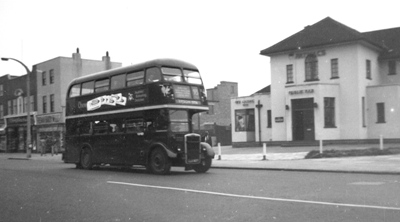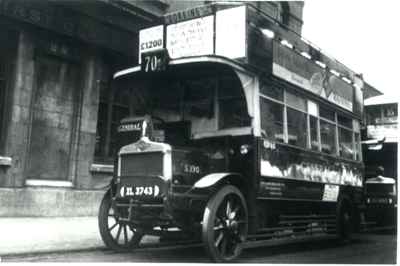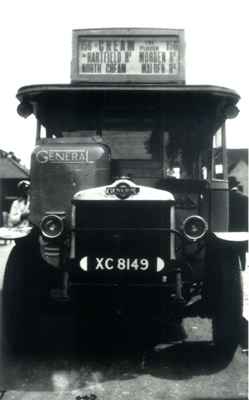Transport history by Derek Fisk
Not being directly served by a railway line, North Cheam
presents an interesting story of how bus services developed in a
purely suburban area. This article reviews the history and
development of those services.
While there was a village at Cheam listed in the Doomsday Book,
there was nothing at North Cheam apart from a crossroads where the
road from Cheam to Malden, the current route of the 213 bus,
crossed London Road, now the route of the 293 bus but originally a
Roman road, Stane Street.
 Before WW1 there was only a handful of houses at this
crossroads, and only two new roads of houses opened in the early
1920s. However, the electrification of the Southern Railway to
Worcester Park in 1925 and Cheam in 1929, together with the opening
of the Tube to Morden in September 1926, changed all that. Houses
filled the area in the years up to 1939 and the Queen Victoria pub
at the crossroads was rebuilt in 1938 in an imposing 1930s style,
although this was demolished in favour of a utilitarian office
building in the 1960s.
Before WW1 there was only a handful of houses at this
crossroads, and only two new roads of houses opened in the early
1920s. However, the electrification of the Southern Railway to
Worcester Park in 1925 and Cheam in 1929, together with the opening
of the Tube to Morden in September 1926, changed all that. Houses
filled the area in the years up to 1939 and the Queen Victoria pub
at the crossroads was rebuilt in 1938 in an imposing 1930s style,
although this was demolished in favour of a utilitarian office
building in the 1960s.
The 1930s-style Queen Victoria provides the
backdrop to Putney Bridge's RTL1048, caught by Vic Youel's
Brownie 127 in 1955. It is working one of the journeys
that continued to Epsom. Today, the awful building
that replaced the Queen Vic appears in its turn to
be ready for demolition.
Photo © Vic Youel
 The policy of the LGOC, and the LPTB which
followed, was to concentrate its suburban bus services on the
principal roads, with little penetration of estate or minor roads.
This policy is amply illustrated in North Cheam, where buses
started running through Morden along London Road to Epsom in 1913,
while another service started from Kingston to Sutton in 1921 along
Cheam Common Road and Malden Road. With the exception of the
lengthy terminal working via Church Hill Road and Priory Road from
1930, no local penetration within North Cheam occurred until the
1990s. However, Sutton Common Road on the northern fringe of the
area saw a bus service from 1961.
The policy of the LGOC, and the LPTB which
followed, was to concentrate its suburban bus services on the
principal roads, with little penetration of estate or minor roads.
This policy is amply illustrated in North Cheam, where buses
started running through Morden along London Road to Epsom in 1913,
while another service started from Kingston to Sutton in 1921 along
Cheam Common Road and Malden Road. With the exception of the
lengthy terminal working via Church Hill Road and Priory Road from
1930, no local penetration within North Cheam occurred until the
1990s. However, Sutton Common Road on the northern fringe of the
area saw a bus service from 1961.
Route 70 from Clapham to Dorking, the route
renumbered from 107A in the 1924 renumbering. S330
is seen awaiting departure on 27 May 30. It was the later
subsidiary route 70D starting from Morden that was
replaced by the 93 and 470. The NS behind is on route 35,
which still serves Clapham Common.
Photo from W Noel Jackson collection, ©
Alan Cross
 The very first route introduced by LGOC to serve North
Cheam was the 107 from Clapham Common to Epsom at Easter 1913.
Initially this ran on Saturdays and Sundays but became Sundays only
from October. It was joined in March 1914 by Sunday only route 164
from Walham Green to Morden and Epsom, while in May the 107 was
extended to Dorking on Sundays. With World War I starting on 4
August, 164 was withdrawn but in August 1915 the 107 became a daily
service to Epsom. In November the 107 ran weekdays to Epsom with
the 107A running Sundays to Dorking. In May 1916 the
107A became the daily route to Dorking, being renumbered
the 70 in 1924.
The very first route introduced by LGOC to serve North
Cheam was the 107 from Clapham Common to Epsom at Easter 1913.
Initially this ran on Saturdays and Sundays but became Sundays only
from October. It was joined in March 1914 by Sunday only route 164
from Walham Green to Morden and Epsom, while in May the 107 was
extended to Dorking on Sundays. With World War I starting on 4
August, 164 was withdrawn but in August 1915 the 107 became a daily
service to Epsom. In November the 107 ran weekdays to Epsom with
the 107A running Sundays to Dorking. In May 1916 the
107A became the daily route to Dorking, being renumbered
the 70 in 1924.
Meanwhile, the 113 route from Kingston to Burgh Heath via
Worcester Park, Cheam and Sutton started in November 1921. The
routeing beyond Sutton saw a sequence of changes until Belmont was
settled on.
Big changes to the pattern of bus services followed the opening
of the Tube to Morden in September 1926. This brought several
feeder services to the London Road to North Cheam: the 155 on to
Worcester Park, the 156 to Cheam Village and the 164 to Ewell and
then Drift Bridge and Burgh Heath. This increased the buses per
hour (bph) on the London Road from 2 or 3 to 8 or 9. Another new
service from Morden was the 131 race day service to Epsom Races,
which survives in less intensive form to this day, although the 131
number was dropped in 1934. In August 1928, the 155 and 156 became
circular routes doubling back to Morden, the 155 via the Kingston
By pass and the 156 via Sutton. In 1930, the 155 was shortened to
run from Morden to South Wimbledon via North Cheam and Worcester
Park and renumbered 155B.
Route 156 was one of the
original single-deck Morden feeder services.
Photo from W Noel
Jackson collection, © Alan Cross
Continued on Page
2